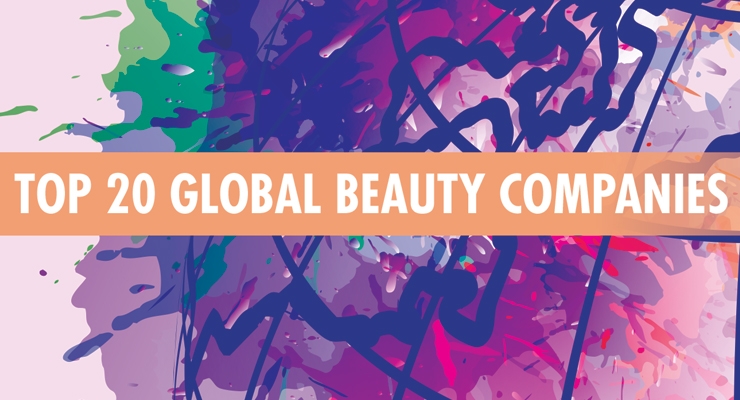Jamie Matusow, Editor-in-Chief, with Joanna Cosgrove, Contributing Editor11.01.19
Update: See our latest report and rankings—Top 20 Global Beauty Companies 2020
New opportunities for cosmetics, fragrance and personal care products seemingly stretch across all countries and cultures, and this year’s Top 20 global beauty companies are wooing consumers with products, technology, CSR—and new packaging for a more sustainable world.
While Beauty Packaging’s Top 20 list for Fiscal 2019 (2018 net sales) has remained relatively stable over the previous year, the world has not—with geopolitical turmoil, rising concerns over climate change, the uncertainty of tariffs, protests in Hong Kong and an increasingly focused consumer eye on sustainable packaging.
Concerning the latter, 2018 may have been the “greenest” year for packaging, to-date.
Nearly every company in these top ranks has devoted significant efforts toward developing containers, cartons, and environmentally responsible practices and procedures, as consumers (and legislators) voice their priorities loud and clear.
In line with the accelerating effect of sustainable corporate strategies on consumer thinking—and purchasing—Shiseido joined several other of the world’s largest beauty manufacturers in claiming beauty for a greater good. The Japanese powerhouse launched a new mission statement—“Beauty Innovations for a Better World”—to further a vision of developing products that “contribute to society and the people of the future.”
Company Beauty Sales
1. L’Oréal $30.8 billion
2. Unilever $23.6 billion
3. The Estée Lauder Companies $14.9 billion
4. Procter & Gamble $12.4 billion
5. Shiseido $9.9 billion
6. Coty $9.3 billion
7. LVMH $6.9 billion
8. Beiersdorf $6.7 billion
9. Johnson & Johnson $6.3 billion
10. Kao $5.7 billion
11. L Brands $5 billion (est.)
12. Amorepacific $4.8 billion
13. Henkel $4.7 billion
14. Avon Products (UK) $3.7 billion
15. Chanel $3.7 billion (est.)
16. Natura & Co $3.5 billion
17. Mary Kay $3.4 (est.)
18. Colgate-Palmolive $3.1 billion
19. Revlon $2.5 billion
20. Kose $2.3 billion
A Bountiful Year for the Global Cosmetics Industry
A few companies on our list may have slipped a bit in sales, others gained—but overall, it was once again a bountiful year for the global cosmetics industry.
In general, Prestige ruled, Skincare shone in every area of the world, Asia was the major growth driver, Travel Retail sales surged ahead, and e-commerce rang up lucrative results. Increased launches in the Men’s and gender-neutral categories proved that the former fringe sector is taking hold.
To help steer these behemoth brands and keep them on course, new executives were brought in at industry leaders including L’Oréal, Unilever, Coty, J&J, L Brands, Avon and Colgate-Palmolive.
Acquisitions and Rumors Of
Brand acquisitions remained strong in 2018-2019, with, for example, Unilever snapping up J-brand Tatcha and Beiersdorf accessing Coppertone to boost its position in the U.S. market.
Rumors swelled of Coty buying Kylie Cosmetics; of LVMH buying Chanel; of L’Oréal buying Clarins’ fine fragrances Mugler and Azzaro; and of Unilever bidding on Drunk Elephant (but Shiseido ultimately ended up with the prize).
The latest word is that Revlon may be up for sale. Talk swirling around Avon’s future was quelled with Natura’s landmark purchase of Avon, which catapults the Brazilian company into position as the world’s fourth largest multi-channel, direct-selling global beauty giant.
Some standouts on our list, including P&G, Beiersdorf and Unilever, are incubating their own brands, priming them for success from the inside.
One thing’s for sure. Staying among the Top 20 is no easy feat—and next year’s elite list may be very different… We’ll be monitoring them closely.
Update
Coty Buys Kylie Cosmetics
Beiersdorf Adds Coppertone to Sun Care Portfolio
LVMH Welcomes Tiffany & Co. To The Family -- for $16.2 Billion
Report Data: Just a note on the compilation of this report: Companies were analyzed based on 2018 data. Beauty sales included only cosmetics, fragrance and personal care items when possible. Figures for companies outside the U.S. were based on the exchange rate for the fiscal year on the day it ended. Estimates are provided in cases where full disclosure was not available.




























